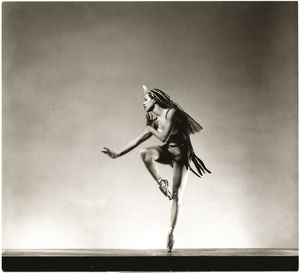By Marshall Terrill, Special to GetOut of The East Valley Tribune

Photo courtesy of Sandy Osawa
Maria Tallchief was considered America’s first major prima ballerina and was the first Native American to hold such distinction.
Tallchief’s innovative role as the first sugar plum fairy in ‘Nutcracker’ and passionate dancing revolutionized the ballet but offstage her life was filled with personal struggles and discrimination.
ASU’s Simon Ortiz and Labriola Center Lecture on Indigenous Land, Culture, and Community presents Sandy Osawa’s ‘Maria Tallchief,’ a documentary that will be screened at 7 p.m. on Thursday, Oct. 16 at the Heard Museum, 2301 N. Central Ave., Phoenix.
Osawa will follow the free screening and lecture with a Q & A about her one-hour documentary, which aired on PBS from 2007-2010. Osawa broke media barriers in the 1970s by launching the first 10-part national television series to be entirely produced, acted and written by Native Americans. She was also the first Native American filmmaker to produce a documentary for network television, called ‘The Eighth Fire,’ first broadcast on NBC stations in 1992.
Osawa spoke to Get Out from her home in Seattle, Washington, to discuss her landmark documentary and the life of one of the most brilliant ballerinas of the 20th century.
Q: What drew you as a filmmaker to Maria Tallchief’s story?
SO: What drew me to her story was the fact that there’s a shocking lack of Native American stories and she had been on my mind for some time. I first heard about her when I was in college, so that had always stayed in the back of my mind. Then years later I met her grown daughter, Elise Maria Paschen, at a writer’s workshop in Oregon. I asked Elise if there had ever been any full-length documentaries on her mother. She said, ‘No, there isn’t.’ Elise then gave me her mother’s number and I called her up. When I asked Maria Tallchief about the possibility of doing a documentary she said, ‘Let’s do it.’
Q: There were some parallels with you and Maria Tallchief in that you are both Native American women who were underrepresented in your respective professions. Did that help you relate to her?
SO: I actually did feel that there were layers, a lot of levels that existed between us. One of them was the fact that Maria Tallchief said she was shy growing up … painfully shy. I also suffered with that aspect of being shy. I went to school in Port Angeles, Washington and although there was a tribe nearby, there really weren’t any Native Americans at my school. Every summer I would go back to the reservation and that was very much a coming home period and it felt positive. Going back to school was the reverse feeling. Maria said she had that same feeling when balancing the Indian and non-Indian world. Maria was also very quiet about her own accomplishments and was reticent to say anything about her amazing career, which meant I had to resort to some of her friends, associates and family to fill in those gaps. Many people who are raised in a traditional Native American setting are not fond of bragging.
Q: I was surprised to discover there were factions in ballet and Tallchief was an outsider in terms of where she fit in this world.
SO: When she started her career, the only star ballerinas that existed were Russian and English, no Americans. For example, she was asked to change her name to Maria Tallchieva to sound Russian. It’s kind of hard to fathom this now, but this was in the 1940s and 1950s. She was America’s first prima ballerina. It’s a huge milestone people and are always asking, ‘Why didn’t we know about her then?’ It’s all boils down to who writes our history and whose story gets told.
Q: In addition to having to overcome hurdles in the ballet world, Maria Tallchief had a lot of personal issues to face.
SO: I think with any artist there are always going to be obstacles in the way and she certainly faced her share of them. Even when she was born there was turmoil. In the film we focus on a time period when she was young where her relatives were being murdered for oil. Being born a girl in that era and in that environment of murder, it did not look like a very good start for Maria. We show that in the beginning to demonstrate the stress that exists in most Native Americans lives. There are difficulties, there’s hardships, and if you happen to be born into oil money, like her family was, there were tremendous obstacles.
Q: Maria Tallchief died in 2013 but was alive when your film first premiered in 2007. What was her reaction to the documentary?
SO: We set up the premiere at the Gene Siskel Film Center in Chicago so that we could be with her in the audience. She was actually living in a nursing home when we screened the film but was able to come that night and she sat in the front row right next to me. When it ended, she got up and publicly thanked us and was very happy with the film. Her daughter later confirmed how appreciative Maria was. It was very nerve wracking for me because when you’re dealing with a legend, you’re very nervous if you’ve nailed it or not. It was a great final affirmation that she was happy and that we had done a great job.
If you go
What: ‘Maria Tallchief’ lecture, film and Q & A
When: 7 p.m. Thursday, Oct. 16
Where: Heard Museum, 2301 N. Central Ave., Phoenix.
Cost: Free
Information: (602) 252-8840 or Heard.org/events
